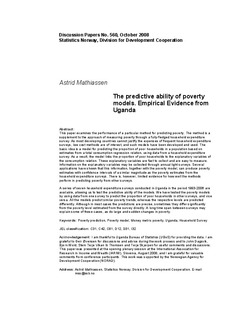The predictive ability of poverty models : empirical evidence from Uganda
Working paper

Åpne
Permanent lenke
http://hdl.handle.net/11250/180403Utgivelsesdato
2008Metadata
Vis full innførselSamlinger
- Discussion Papers [1002]
Sammendrag
Abstract:
This paper examines the performance of a particular method for predicting poverty. The method is a supplement to the approach of measuring poverty through a fully-fledged household expenditure survey. As most developing countries cannot justify the expenses of frequent household expenditure surveys, low cost methods are of interest, and such models have been developed and used. The basic idea is a model for predicting the proportion of poor households in a population based on estimates from a total consumption regression relation, using data from a household expenditure survey. As a result, the model links the proportion of poor households to the explanatory variables of the consumption relation. These explanatory variables are fast to collect and are easy to measure. Information on the explanatory variables may be collected through annual light surveys. Several applications have shown that this information, together with the poverty model, can produce poverty estimates with confidence intervals of a similar magnitude as the poverty estimates from the household expenditure surveys. There is, however, limited evidence for how well the methods perform in predicting poverty from other surveys. A series of seven household expenditure surveys conducted in Uganda in the period 1993-2006 are available, allowing us to test the predictive ability of the models. We have tested the poverty models by using data from one survey to predict the proportion of poor households in other surveys, and vice versa. All the models predict similar poverty trends, whereas the respective levels are predicted differently. Although in most cases the predictions are precise, sometimes they differ significantly from the poverty level estimated from the survey directly. A long time span between surveys may explain some of these cases, as do large and sudden changes in poverty.
Keywords: Poverty prediction, Poverty model, Money metric poverty, Uganda, Household Survey
JEL classification: C31, C42, C81, D12, D31, I32
Utgiver
Statistics Norway, Research DepartmentSerie
Discussion Papers;No. 560Beslektede innførsler
Viser innførsler beslektet ved tittel, forfatter og emneord.
-
The impacts of alternative policy instruments on environmental performance. A firm level study of temporary and persistent effects
Bye, Brita; Klemetsen, Marit Elisabeth (Discussion papers;788, Working paper, 2014-10)We study the effects of various environmental regulations on environmental performance measured as emission intensity. Moreover, we aim to test whether any such effects are persistent or only temporary. Conventional theory ... -
The welfare effects of carbon policies: grandfathered quotas versus differentiated taxes
Bye, Brita; Nyborg, Karine (Discussion Papers;No. 261, Working paper, 1999)Recently, it has been demonstrated that pre-existing distortionary taxes can substantially increase the costs of market-based instruments which do not raise revenue, such as non-auctioned emissions quotas. Revenue-raising ... -
Labour market rigidities and environmental tax reforms : welfare effects of different regimes
Bye, Brita (Discussion Papers;No. 242, Working paper, 1998)The working of the labour market is important for the total welfare effects of tax reforms. This paper analyses, by using a computable general equilibrium model for the Norwegian economy, how different assumptions about ...